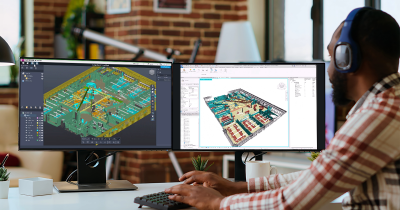SPONSORED BY LEICA GEOSYSTEMS
At ILMF 2018, Leica Geosystems is showcasing its brand new mobile mapping system, the Pegasus:Two Ultimate. This system is an upgrade over the previous Pegasus:Two, and features greatly improved 360° imagery capture, as well as added sensor ports, a removable SSD hard drive, and a new web sharing platform.
Together, these upgrades enhance the usability of the Pegasus system in high-volume production applications—in particular, smart city mapping.
We talked to VP of mobile mapping Stuart Woods to find out more.
360° imagery that “pops”
Woods explains the new system as a refinement of the Pegasus:Two, featuring the same survey-grade 3D capture, but with upgraded cameras that produce “true, stitchless 360° imagery that can be overlaid on the lidar.” That means no more stitching errors causing jagged telephone polls or curved signs in your 360° images. It means greater confidence in your data.
Leica Geosystems’ creative approach to 360° image capture makes this feat possible. Woods says that most current 360° image sensors use six different cameras, which are very difficult to arrange such that they overlap well enough to generate seamless images. “When you’re using so many cameras,” Woods says, “you’re forced into the position where you’re never going to get it right.”
The solution for the Pegasus:Two Ultimate was to reduce the number of cameras used for 360° capture to two, and to make sure those cameras had higher-quality sensors to make up for the difference in megapixels. With careful calibration, these cameras produce stitchless 24 MP 360° imagery.
That’s not the only improvement to the system’s imagery capture. Leica Geosystems has added onboard JPEG compression, which enables in-camera color correction for imagery that Woods says “absolutely pops.”

The importance of good imagery
This 360° imaging upgrade is crucial, Woods argues, because “the concept of imagery is a lot more commanding on systems than it used to be.”
A new mobile mapping system needs to have strong imagery in order to “represent and create the digital reality we need for smart city and visualization markets. You have to marry traditional survey with strong visual imagery because we humans are very visual, and like it or not, that’s how we relate to digital data.”
In the past, he says, systems tended to produce weak 360° imagery that limited the usefulness of mobile mapping systems. “You know if you’re using this imagery for any kind of GPS applications,” says Woods, “it means there’s also an error in your measurement. If you’re talking about using the system to grow the smart city market, it introduces a question of confidence. If telephone polls don’t look straight, or appear the way they should, it slows the market.”
Hardware updates for high-volume mapping
Woods says that the past four and a half years on the mobile mapping market has taught the company a lot about what drives a high-volume production mobile mapping system, and the new features in the Pegasus:Two Ultimate reflect that fact.
The on-board JPEG compression mentioned above, for example, doesn’t just make better images. It also performs the compression at the point of capture, helping to reduce the load on the computer so it can process sensor data, and perform tasks like positioning, at a much greater speed.
Pegasus:Two Ultimate now includes a removable USB-C hard drive, which users can eject and simply plug into a computer back in the office for data transfer. Leica has also added two more sensor ports to the system, which allows users to augment their Pegasus data with everything from sonar for underwater mapping, to thermal cameras, to ground-penetrating radar for capturing underground utilities.
According to Woods, Leica Geosystems “found our customers wanted a system that—when a situation arose and they wanted to capture a city in ones and zeroes—the system gave them the capacity to do that.”
New cloud-based sharing platform
The last piece of the puzzle, of course, is the software for processing this high volume data and making it easy for everyone to use. “One of the key points,” says Woods, “is to enable our customers and our clients to be able to invoice and share the data quickly.”
To that end, Leica is launching a cloud-based web viewer that can share and visualize high volumes of data in any browser, from any location. This has the added benefit of “democratizing the visual world and getting the 3D data to the point where those that need to access the data in a smart city environment can have access to it.”
The smart city mobile mapper
Woods explained that the smart city market is growing, and there are a lot applications in the space that qualify as “low-hanging fruit” for the right mobile mapping system.
“What does that mean?” he asked. “Well, providing the capacity to better manage parking in a city, for example. This really comes down to GIS—so being able to clearly map out those spaces, and know where they are, and then turn them over to a system that is automated. We see these types of applications as the low-hanging fruit of smart cities.”
This is the next wave for mobile mapping, he says, and the Pegasus:Two Ultimate is just the system for the job. See Leica Geosystems in ILMF booth #212 for more information.









